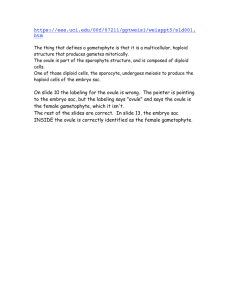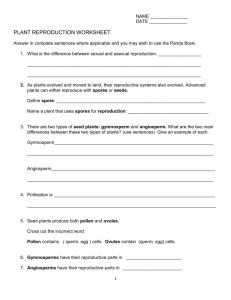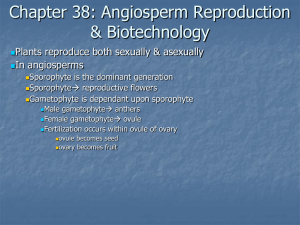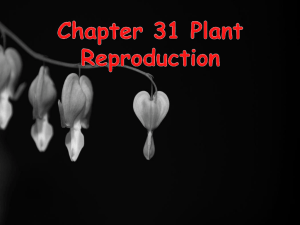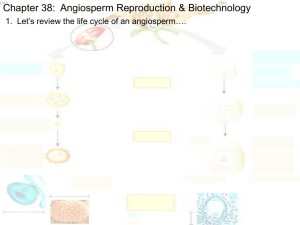Chapter 38 à Angiosperm Reproduction and Biotechnology Student
advertisement
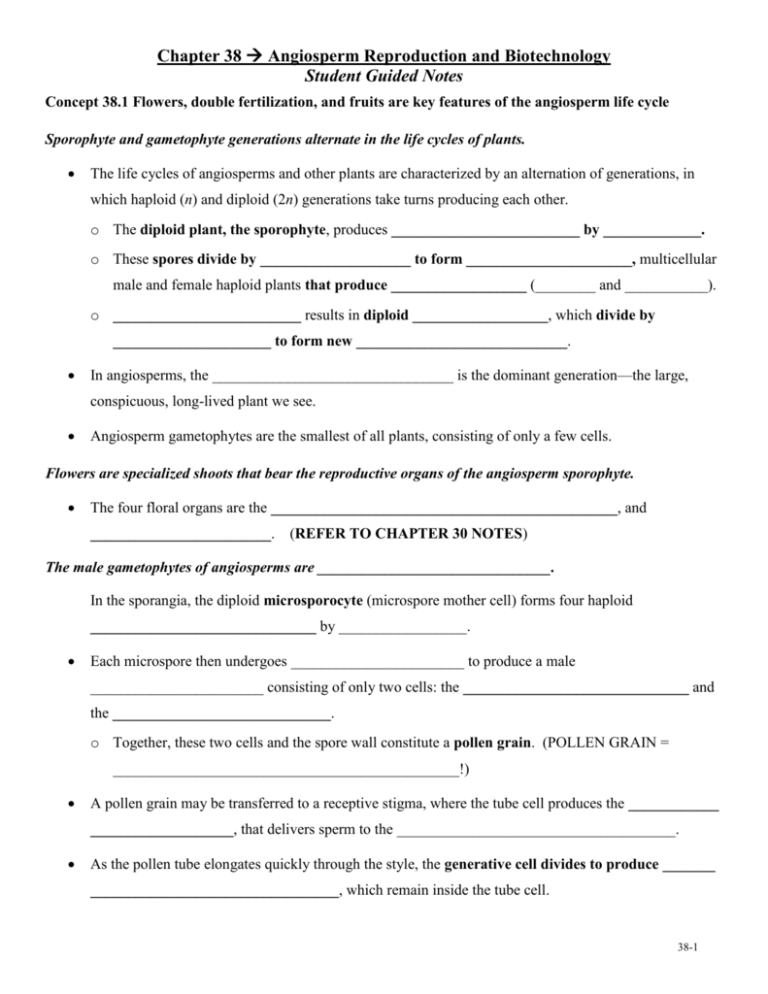
Chapter 38 Angiosperm Reproduction and Biotechnology Student Guided Notes Concept 38.1 Flowers, double fertilization, and fruits are key features of the angiosperm life cycle Sporophyte and gametophyte generations alternate in the life cycles of plants. The life cycles of angiosperms and other plants are characterized by an alternation of generations, in which haploid (n) and diploid (2n) generations take turns producing each other. o The diploid plant, the sporophyte, produces _________________________ by _____________. o These spores divide by ____________________ to form ______________________, multicellular male and female haploid plants that produce __________________ (________ and ___________). o _________________________ results in diploid __________________, which divide by _____________________ to form new ____________________________. In angiosperms, the ________________________________ is the dominant generation—the large, conspicuous, long-lived plant we see. Angiosperm gametophytes are the smallest of all plants, consisting of only a few cells. Flowers are specialized shoots that bear the reproductive organs of the angiosperm sporophyte. The four floral organs are the ______________________________________________, and ________________________. (REFER TO CHAPTER 30 NOTES) The male gametophytes of angiosperms are _______________________________. In the sporangia, the diploid microsporocyte (microspore mother cell) forms four haploid ______________________________ by _________________. Each microspore then undergoes _______________________ to produce a male _______________________ consisting of only two cells: the ______________________________ and the _____________________________. o Together, these two cells and the spore wall constitute a pollen grain. (POLLEN GRAIN = ______________________________________________!) A pollen grain may be transferred to a receptive stigma, where the tube cell produces the ____________ ___________________, that delivers sperm to the _____________________________________. As the pollen tube elongates quickly through the style, the generative cell divides to produce _______ _________________________________, which remain inside the tube cell. 38-1 o The pollen tube grows into the ______________________, where it releases the sperm cells near the female gametophyte. The female gametophyte of an angiosperm is an embryo sac. The development of the embryo sac occurs in the tissue within each ovule called the _______________________________. (EMBRYO SAC = __________________________________) The diploid megasporocyte (or megaspore mother cell) forms four haploid _____________________ by meiosis. o Only _____________ megaspore survives; the others degenerate. The nucleus of the surviving megaspore divides by mitosis _____________ times without cytokinesis, resulting in one large cell with _________________ haploid nuclei. At one end, two cells called synergids flank the egg cell and help _____________________________ __________________________________________________________________________________. At the opposite end of the embryo sac are three ___________________________ of unknown function. The other two nuclei, called ____________________________________, share the cytoplasm of the large central cell of the embryo sac. OVERVIEW - Development of Pollen (male gametophyte) o In sporangia (pollen sacs) are diploid cells (called microsporocytes) that divide by meiosis to form haploid microspores, which give rise to pollen (male gametophyte) o Two cells: __________________ cell = produces sperm; ________ cell = produces pollen tube o Pollen = ___ sperm - Development of Embryo Sac (female gametophyte) o Ovary → ovule → megasporocyte → goes thru meiosis forming 4 megaspores – only 1 survives o One end of the embryo sac has 1 egg and 2 synergids (which are used for attraction/ guidance of pollen tube) - ____ antipodal cells - ____ polar nuclei - ____ egg - ____ synergids 38-2 Double fertilization gives rise to the zygote and endosperm. o Synchronizes ___________________________________ with _____________________ o 1 sperm + egg = 2n ____________________ o 1 sperm + 2 polar nuclei = 3n _____________________________ (FOOD!) o BOTH sperm fertilize nuclei in the female gametophyte (REFER TO Chapter 30 Notes) The ovule develops into a seed containing an embryo and a supply of nutrients. After double fertilization, the ovule develops into a ________________, and the ovary develops into a __________________ enclosing the seed(s). The embryo develops within the seed. During the last stages of maturation, a seed dehydrates until its water content is only about 5–15% of its weight. The embryo stops growing and enters ___________________________ until _____________________ ____________________________________. o The embryo and its food supply are enclosed by a protective __________________________ formed by the integuments of the ovule. Seed dormancy is an adaptation for tough times. The conditions required to break seed dormancy and resume growth and development vary among species. o Some seeds germinate as soon as they are in a __________________________________________. o Others remain dormant until some specific environmental cue causes them to break dormancy. Germination of seeds depends on imbibition, _____________________________________________ __________________________________________________________________________________. o Imbibition causes the expanding seed to ___________________________________________ and triggers metabolic changes in the ______________________ that enable it to resume growth. The first organ to emerge from the germinating seed is the ___________________________, the _______________________________________. Next, the _______________________________ must break through the soil surface. 38-3 The ovary develops into a fruit adapted for seed dispersal. As the seeds are developing from ovules, the ovary of the flower is developing into a fruit, which protects the enclosed seeds and aids in their dispersal by _______________ or ____________________. During fruit development, the ______________________ wall becomes the pericarp, _____________ _________________________________________________________. Fruits are classified into types, depending on their ___________________________________________. Simple fruit → develops from a single ovary; ex. cherry, soybean Aggregate fruit → single flower, several carpals; ex. blackberry Multiple fruit → tightly clustered group of flowers; ex. pineapple Concept 38.2 Flowering plants reproduce sexually, asexually, or both Many plants clone themselves by _____________________ reproduction (also called clonal reproduction), in which _______________________________________________________________ ___________________________________________________________________________________. Detached vegetative fragments of some plants can develop into whole offspring. o In ____________________________________ (making cuttings of plants), a parent plant separates into parts that re-form into ______________________________. o This can also occur naturally! A different method of asexual reproduction, called apomixis, is found in ________________________ and some other plants. o These plants produce seeds _________________________________________________________. Both sexual and asexual reproduction have advantages and disadvantages. Many plants are capable of both sexual and asexual reproduction, and each offers advantages in certain situations. If a plant is well suited to a stable environment, asexual reproduction has advantages. o A plant can clone many copies of itself rapidly. Generally, the clones produced by _________________________ reproduction are not as frail as the seedlings produced by _____________________________ reproduction. o The clones are usually ___________________________________ of the parent plant, which is why asexual reproduction in plants is also known as ________________________________________. 38-4 Seeds produced by sexual reproduction can disperse to new locations and wait for favorable growing conditions. o Seed dormancy suspends growth until hostile environmental conditions are reversed. The major advantage of sexual reproduction is increasing the __________________________________ of offspring. Plants have various mechanisms that prevent self-fertilization. The various barriers that prevent self-fertilization contribute to genetic variety by ensuring that the sperm and egg come from different parents. The most common anti-selfing mechanism is self-incompatibility, __________________________ ________________________________________________________________________________. o If a pollen grain from an anther happens to land on a stigma of a flower on the same plant, a _____________________________________________________________________________ _____________________________________________________________________________. The self-incompatibility systems in plant are analogous to the _________________________________ of animals. o Both are based on the ability of organisms to distinguish __________________________________. o The key difference is that the animal immune system rejects _____________________, whereas self-incompatibility in plants is a rejection of ________________________. Plant breeders frequently hybridize different varieties of a crop plant to combine the _______________ _______________________________ and counter the __________________________________ that can result from ______________________________________________. Vegetative propagation of plants is common in agriculture. In a multicellular organisms, any cell that can _____________________________________________ _______________________________________________________________ is said to be totipotent. o Transgenic plants are ____________________________________________________________ ______________________________________________________________________________ ____________________________. (in other words: genes from two of more species in one plant) o Test-tube culture makes it possible to regenerate a GM plant from a _________________________ ________________________________________________________________________________. o Transgenic plants can also happen naturally (not just by genetic engineering). 38-5 Concept 38.3 People modify crops by breeding and genetic engineering including the following examples: Humans have created new plant varieties by artificial selection. Humans have intervened in the reproduction and genetic makeup of plants for thousands of years. _____________________________________ by humans has created plants that could not survive or reproduce in the wild. For domesticated crop plants, genetic modifications began long before humans started altering crops by artificial selection (for example: wheat groups undergo natural hybridization.) The term plant biotechnology has two meanings. o In the general sense, it refers to ____________________________________________________ (or substances obtained from plants) to make _____________________________________________ ________________—an endeavor that began in prehistory. o In a more specific sense, it refers to ___________________________________________________ ________________________________________________________________________________. The terms ______________________________________ and ____________________________ have become synonymous in the media. Unlike traditional plant breeders, _______________________________________________ are not limited to transferring genes between _____________________________________________ or varieties of the same species. In summary: There is much debate about plant biotechnology political, economic and ethical issues 38-6

